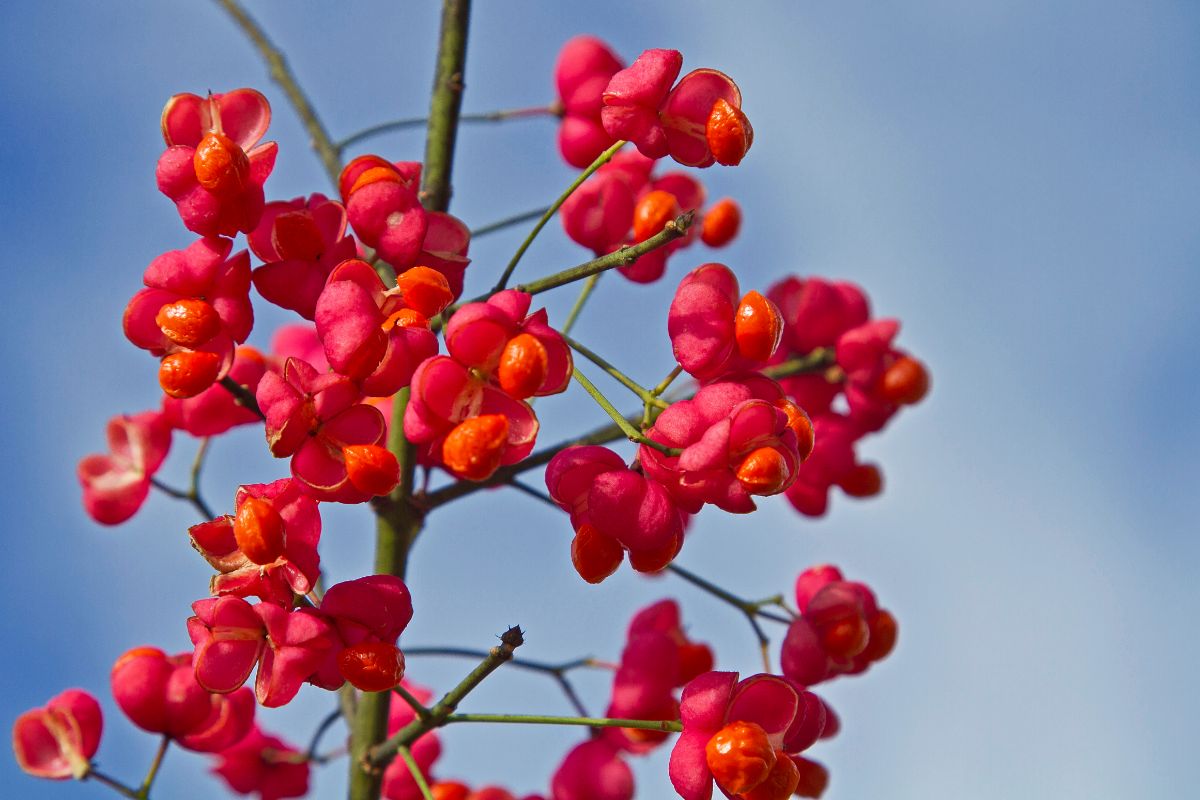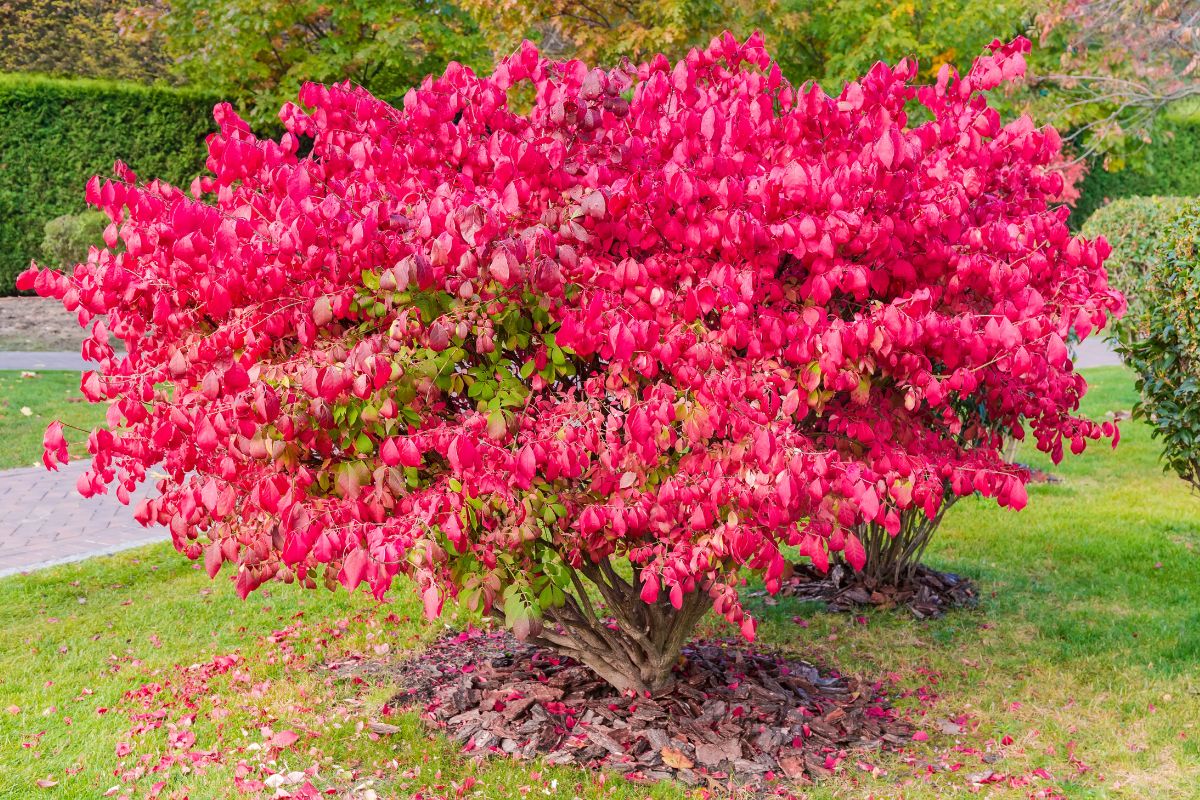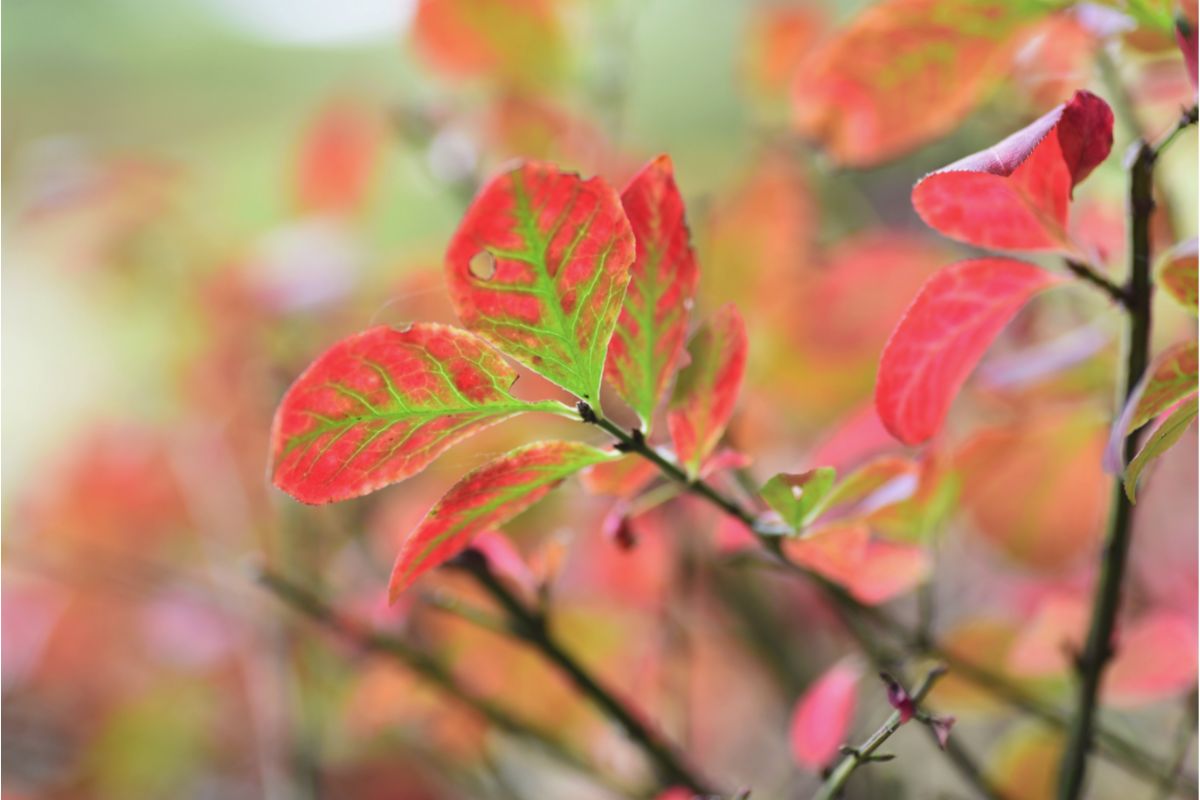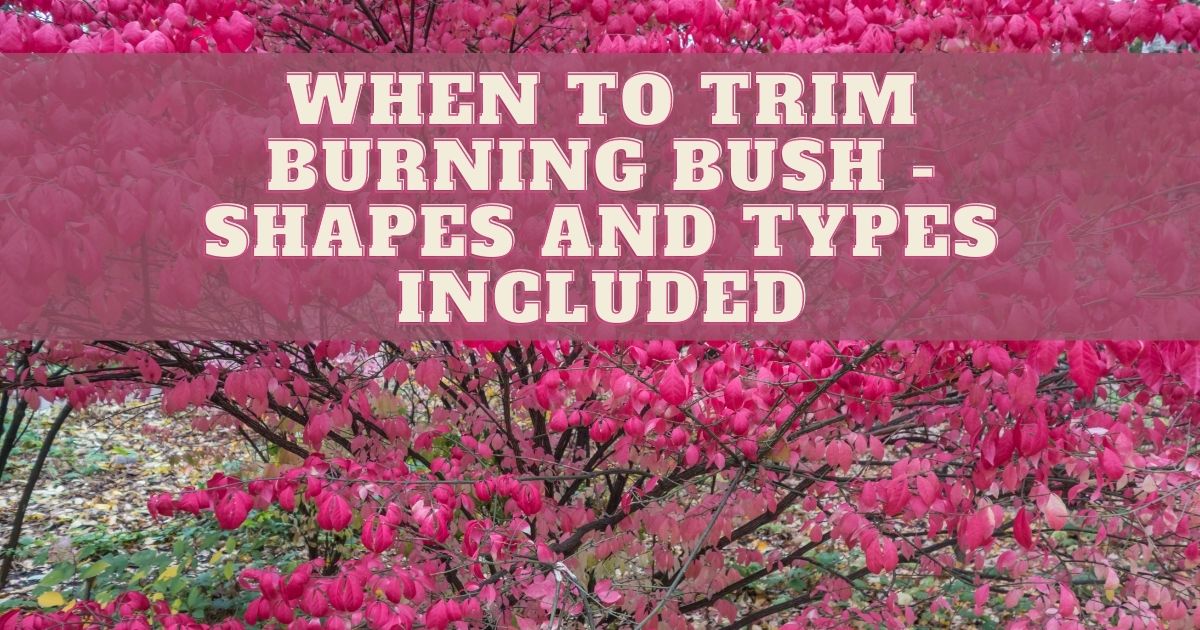What is a Burning Bush?
The burning bush (Euonymus alatus) is a striking addition to any garden or landscape. However, it is essential to learn when to trim burning bush. It’s a popular shrub but prone to “overgrowing.”
This bush is easy and not as low-maintenance as it is beautiful. It is ideal for growing as a single large specimen plant or in a row to create a low privacy screen.

Pruning Burning Bush–Our How-to Guide
You may be wondering, how do I prune an overgrown burning bush? You can do it in various ways;
Pruning for Shape
Step One
The first step is to identify when to prune the bush. The first pruning should take place in late winter or early spring. You’ll probably need two pruning exercises per year to shape a flaming shrub. You should do the first burning bush spring pruning before new growth appears. You can also do it in late winter.
As they develop, burning bushes can become huge and wild. Still, you can typically keep them in check by trimming them into a desirable shape. This form of pruning will keep the shrub looking great for the season while also preventing it from overgrowing.
Step Two
Pick a shape to work with. You can leave the flaming bush naturally or prune it into an aesthetic hedge shape.
Pruning the bush into a typical cube, box, or globe hedge shape is a good option. Another alternative is to remove the lower branches entirely, leaving only the rounded top. The burning bush would resemble a little tree if you did this.
Start with a snapshot or sketch if you’re having trouble imagining your perfect shape. You might also draw your diagram to assist you in the process.
Step Three
Cut the branches to the desired shape. Remove any branches that reach beyond the preferred shape of your burning bush with hedge clippers once you’ve pictured it. Cut a branch or twig back to a point above a bud or side branch when shortening it.
Unless you eliminate the bottom part of the bush, the top of the bush should be slightly thinner than the bottom. This will allow sunlight to reach all of the shrub’s leaves. Notably, a large top can prevent enough sunlight from reaching the bottom, leading the plant to grow unhealthy.
Step Four
Trim back some of the internal branches. You should trim away some of the dense internal branches when pruning burning bushes into hedge forms to increase the spread of air and sunshine through the plant.
Use pruning shears to trim inward developing branches down to an outward-facing bud or branch. This exercise redirects inward-growing branches to grow outward and make the bush less thick.
Step Five
Later in the season, prune back new growth. You should prune the flaming bush again in the middle of summer to keep it in good shape.
Because many people burn bushes for their autumn leaves. So, don’t worry about accidentally destroying flower buds when pruning in the summer.
However, wait until new growth reaches a length of 6 to 8 inches (15 to 20 centimeters) to identify a more specific period for summer pruning. You should trim down new growth within 2 inches (5 centimeters) following your spring pruning.
Rejuvenation Pruning
Step One
The most extreme form of pruning is rejuvenation pruning, and you should know when to do it. You should do it in the early spring or late winter when new growth will be growing, and the bush will be able to recover quickly. If the flaming bush is overgrowing very fast or it is sickly, do this form of pruning.
After rigorous trimming, a healthy burning bush should grow back vigorously. You may need to do this procedure every year until you remove all of the thick, overgrowing trunks.
You can let the bush grow to any height and manage it with regular health or shape pruning after it develops thinner stems. In some cases, your pruning will depend on the dwarf burning bush spacing.
Step Two
Cut the bush all the way down to the ground. Cut all branches down with hedge shears until they are not more than 6 to 12 inches (15 to 30 centimeters) above the ground.
Make sure you leave it at least 1 to 3 inches (2.5 to 7.6 centimeters) above the ground while chopping down the entire bush. To increase the bush’s chances of recovering completely, make sure the cuts are clean and crisp.
Step Three
Throughout the season, give the bush plenty of food and water. Because of the severity of this pruning procedure, you’ll need to pay special attention to the bush during the first growing season after you prune. Water the plant regularly and fertilize appropriately.
Water the burning bush once a week during the first spring and summer. Water it first thing in the morning or before the afternoon sunsets, and make sure the soil beneath it is thoroughly moist.
Fertilize the bush twice: first in the early spring, right after you prune it, and again in the late summer or early fall, about two months before the first frost. Choose a nitrogen-rich fertilizer and follow the package instructions to identify the best application strategy.

When to Trim Burning Bush
Learning when and how to prune a burning bush is very important. Try to determine what size you want the bush to be on average and prune it to that size after measuring it with tape. After a few pruning sessions, you’ll know when and how much to prune the shrub.
- You can prune these bushes at any time of year when you think is appropriate; however, if you believe they have grown too large and are obstructing other trees or plants, it is time to trim them.
- If the burning bush in your garden has grown to the point where it is blocking your garage door or a path, you can trim it using shears.
- In the autumn, the burning shrub becomes a striking bright red color. Pruning the bush when it is young is the best option.
- If you’re going to do a lot of extreme/rejuvenating pruning, do it in the early spring. You’ll avoid the mess since you’ll be through with trimming before any new growth appears.
- If you’re trimming the bush to a specific shape, do so when it’s dormant in the early spring or late winter.
Which is Best for a Burning Bush – Sun or Shade?
The optimal conditions for growing the burning bush are partial shade to full sun. It develops and takes on its well-known vivid red hue when you plant and cultivate them in full sunshine. It can, however, turn bright red in locations with only a few hours of shade per day. This colorful shrub thrives in regions with strong, hot sun and light, shady afternoons.
While the burning bushes thrive in the shadow, long periods of shade will detract them from getting the anticipated brilliant fall color. Too much shadow may result in a more faded reddish color. Though it’s a lovely color, it doesn’t have the same impact as the popular vivid red hue.
Suggested Burning Bush Shapes
Burning shrubs are hardy plants that can withstand a lot of trimming. You don’t need to be a pro when it comes to pruning this shrub. You only need a decent pair of shears and a ladder if the bushes are overgrown.
You can prune these bushes into several shapes, including rectangles, squares, globes, and even tree-like shapes. Because square and rectangular shapes aren’t natural plant shapes, strive to make the shrub spherical.
The Spherical Shape
- Cut the bush into a tree-like shape if you want it to look more natural.
- Use hedge cutters to keep parts of the vertical branches bare for this shape.
- Remove the smaller branches and all of the leaves on the sides.
- After the bush has grown to 5 to 7 feet (1.5 to 2.1 meters), prune it in a semi-circular shape.
The Shape of a Globe
- The globe shape is the most excellent shape for a burning bush. First and foremost, remove all of the burning bush’s unhealthy, infected, and damaged branches.
- Next, choose a central branch that will serve as the primary trunk.
- Trim the surplus branches from some of the side branches.
- Now, trim the edges of the branches you’ve chosen to give them a perfect spherical shape.
Apart from pruning at the appropriate time and in the proper shape, there are more things to remember.
- When pruning, remember to cut at a 45° angle. This tilt aids in better growth control.
- These plants are growing at an alarming rate. If you don’t want to prune it, move it to a location where it can grow as big as possible.
- Monoculture (the growth of only one type of plant) originates from the burning bush, competing with other natural plants. If you plan to plant these bushes, make sure you understand whether they may interfere with the growth of native plants.
- You can also use other plants to replace the bush, such as oakleaf hydrangea, sumac, or chokeberry.
- When they turn red, these bushes are beautiful in the fall, but you must trim them regularly to stay in good shape.
What do Burning Bushes Look Like?
Mounded shrubs with many stems and sharp branches make up the burning bush. They’re a real eye-catcher with vivid red leaves that look like they’re on fire in the fall. They fall off in the winter, revealing the bushes’ highly rigid, green-brown stems.
Burning bush shrubs have rich blue-green foliage in the spring and summer, in stark contrast to their reddish color in the fall. Also, burning bush shrubs reach a maximum height and width of 4 to 8 feet (1.2 to 2.4 meters), making them ideal for a show-stopping specimen.
Ideal Growing Conditions for Burning Bushes
Burning bush shrubs are tough, tenacious plants that thrive in many soil and light conditions and are pest and drought-resistant.
Light
Burning bush shrubs prefer full sun with at least six hours of direct unfiltered sunshine per day, but they can also thrive in partial shade. Plant them in direct sunlight for the most vibrant hues. Too much shade might result in a faded, pinkish tone in the fall.
Soil
Burning bush shrubs can thrive in a variety of soil conditions. Soil PH does not affect their growth, and they may survive in various environments, including sand and clay. However, the soil, on the other hand, must be semi-moist and well-drained.
Watering
Burning bush shrubs are drought-tolerant once planted. However, water more frequently in the first few months after planting. Then, reduce watering to an equivalent of 1 inch (2.5 centimeters) of rain per week.
Fertilizing
Feed your burning bush shrub with a slow-release fertilizer made specifically for trees and shrubs early in the spring. This will prepare your shrub for a spring flush of growth.
Pruning
Late winter or early spring is the best time to prune your burning bush shrub, either in shape or to encourage new growth. To promote the formation of a healthy bud, remove any dead, damaged, or diseased wood near the main branch.
Different Types of Burning Bush Pruning
Pruning (Light)
It’s meant for keeping the burning bush in shape. This is something that you can do at any time of the year. During the summer, cutting overgrown branches down to the bush’s earlier form helps keep it in shape. We recommend trimming branches at a 45° angle to allow water to drain off quickly.
Pruning Regularly
Pruning is the best when you do it regularly before new growth begins, usually in late winter or early spring. During this period, you should get rid of any dead or unhealthy wood. Pruning dead plant portions or removing dead or diseased wood near the main branch aids in the formation of healthy buds, allowing healthy wood to sprout.
Pruning Intensively
When you neglect your burning bush (typically due to lack of routine pruning), it will require more invasive pruning to be back in shape. Before new growth, you should do heavy pruning in late winter or early spring. To begin with, trim a third of the young canes developing around the base of the Burning Bush down to the ground level.
Pruning to the Bone
This happens when you ignore the burning bush for a long time. The plant becomes overgrown or unhealthy. You must cut the entire burning bush to ground level with a saw. This provides ample time for new growth.

The Final Say
If the lush is green in the spring, this magnificent plant becomes crimson-colored. People usually plant dozens of them in a single roll. Notably, pruning a burning shrub is not difficult; all you need are a few fundamental skills.
To keep the growth of a burning bush (Euonymus alatus) under control, you must prune it regularly. In USDA plant hardiness zones four to eight, a shrub can reach a height of 15 to 20 feet (4.5 to 6.1 meters) and have a width of 6 to 10 feet (1.8 to 3 meters). So, trimming your burning bush helps to increase the bush’s growth, health, and attractiveness.
